LITS Annual Report: Foundational
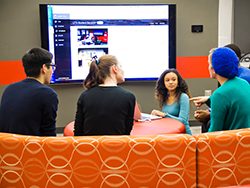 Network and software upgrades were key elements of FY15 as were the Library’s two-year strategic plan and significant improvements to Emory’s IT security posture.
Network and software upgrades were key elements of FY15 as were the Library’s two-year strategic plan and significant improvements to Emory’s IT security posture.
Two-year Library Roadmap
The Libraries have completed a year-long inclusive process to develop a strategic framework/roadmap for the next two years. The framework conveys our vision, mission, values, and guiding principles as well as programmatic themes and goals. Goals associated with the framework were identified to assist in building a solid organizational foundation, to enhance the Libraries engagement with the campus and broader community, and to advance the success of the university’s students, faculty and staff.
We began the year long process by working collaboratively with the campus HR organizational development department and out of those discussions emerged the basis of the Framework. The themes are organizational development and culture, infrastructure and innovation, collaboration and engagement, and community and customer focus. From there the Libraries directors worked within their departments to clarify areas of focus and gather input. The final draft of the framework was recently distributed to staff for feedback.
In the coming year we will disseminate the information internally and externally through a number of avenues. Assessment metrics and goals will be associated with the framework as will departmental and individual goals. Throughout the year we will check in with our progress, make adjustments where needed, and celebrate our success.
Network Stability
 A major goal for this fiscal year has been to increase the overall reliability and availability of Emory’s network through a series of redesign initiatives and equipment refreshes. This year’s work has included major hardware and software upgrades to the core, border, and wireless networks. While some of the core and border work will carry over into next fiscal year, the benefits of this year’s work are already being felt from a noticeable decrease in major network incidents. In addition to improving the resiliency of the network, these changes have also increased the overall capacity of the network.
A major goal for this fiscal year has been to increase the overall reliability and availability of Emory’s network through a series of redesign initiatives and equipment refreshes. This year’s work has included major hardware and software upgrades to the core, border, and wireless networks. While some of the core and border work will carry over into next fiscal year, the benefits of this year’s work are already being felt from a noticeable decrease in major network incidents. In addition to improving the resiliency of the network, these changes have also increased the overall capacity of the network.
Enterprise Application Upgrades
The FY15 focus for Enterprise Application teams has been on application upgrades. In addition to maintaining vendor support, we continue to leverage our ERP investment as we realize new value from the current versions of the application. The most significant of these projects is the PeopleSoft Financials (“Compass”) application upgrade to version 9.2. The purpose of this project has been to:
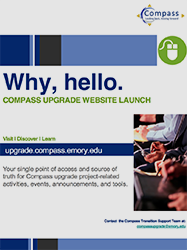 Provide continuous operational improvements to the University and Healthcare communities.
Provide continuous operational improvements to the University and Healthcare communities.- Take advantage of new and improved PeopleSoft functionality.
- Pursue opportunities to reduce our cost of ownership through a reduction of customizations.
- Try to provide more intuitive user interactions and expand functionality to better support business needs.
- Evaluate opportunities for process improvements.
PeopleSoft Campus Solutions (“OPUS”), PeopleSoft HR and ELMs were upgraded to a new version of PeopleTools 8.4 as well as new hardware. In the last quarter of FY15, Verint (Call Center Management) and OnBase (Content management) were also upgraded with the shared purpose of the Compass 9.2 upgrade—building on our investment in enterprise applications to bring more value to the institution.
Emory Business Intelligence
The first phase of the Emory Business Intelligence (EBI) implementation was focused on financial data. In FY15, the Enterprise Applications DW/BI team continued to develop and further enhance deliverables in EBI Finance. With over 400 users, the value gained from efficiencies in reporting are significant in time-savings alone. For one unit, they are saving 15-20 hours per week by using the Financial Trend reports.
While continuing to support EBI Finance, the project to add student data began in Fall of 2015. With participation from the Office of the Registrar and Institutional Research, a dashboard with Degree Statistics has been released as the first step to building a Graduation/Retention dashboard. In addition to building the subject areas for the foundational data, the project has converted data from Fall 2000 to present.
Replacement of Billing, Process Review and Mysoft
During FY15, Library & IT Services (LITS) launched a few initiatives aimed at evaluating some of our core services and their associated processes and costs. We engaged WTC Consulting to help us conduct an assessment of the business processes for an identified subset of billable services. In order to set the proper foundation, we began by documenting the current state of business processes and looked for improvement opportunities and guidance from the consultants on potential best practices. It was imperative to us to also get the customers’ perspectives on how they engage LITS to order these services, their view of the fulfillment process and finally the accuracy and completeness of their invoices.
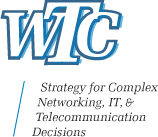 At the same time, another team within WTC was working with us on a comprehensive cost study focusing on voice, data and wireless network services. The desired end state was to be able to compare our rates with other like institutions. WTC was a big help in being able to ensure that the comparison was normalized to account for differences between organizations. The process documentation completed in the earlier endeavor served us well as it was easier to identify tasks and time that make up much of our cost.
At the same time, another team within WTC was working with us on a comprehensive cost study focusing on voice, data and wireless network services. The desired end state was to be able to compare our rates with other like institutions. WTC was a big help in being able to ensure that the comparison was normalized to account for differences between organizations. The process documentation completed in the earlier endeavor served us well as it was easier to identify tasks and time that make up much of our cost.
Our final initiative kicked off this year was to replace the MySoft system as it approaches end of life. Our primary goal is to leverage and integrate other existing Emory systems to simplify and complete the necessary work to provide an accurate bill for LITS services. We are preparing to start an integration pilot and intend to have a new system in place by the start of FY17.
Two-factor Authentication Prep
 LITS Security has completed the first phase of a two-phase process for adding two-factor authentication. The first step was to review and select the appropriate vendor that offered the most user-friendly solution available. The primary feature includes a smart-device popup that users simply accept in order to continue accessing whatever protected system they wish. The vendor also has support options for users who do not have smart-devices.
LITS Security has completed the first phase of a two-phase process for adding two-factor authentication. The first step was to review and select the appropriate vendor that offered the most user-friendly solution available. The primary feature includes a smart-device popup that users simply accept in order to continue accessing whatever protected system they wish. The vendor also has support options for users who do not have smart-devices.
Over the past eight years, IT Security has improved the security posture of the enterprise from behind the scenes. This layer of protection is a customer-facing effort that will make a dramatic impact once we implement the solution in FY16.
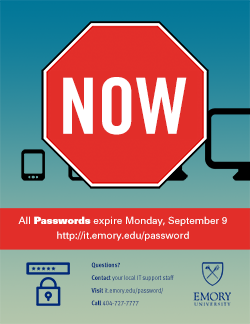 Implementation of the Enterprise Password Policy
Implementation of the Enterprise Password Policy
The Enterprise Password Policy change involved two major components: coming to a password policy agreement between all stakeholders across the university and healthcare and implementing the enterprise authentication system by September 9, 2015. Emory Healthcare already had a comparable policy, but they had a subset of users who were not covered so they adopted the new overarching policy. As of September 9, the entire enterprise is operating under a consistent password policy, with identical password change and complexity requirements.
From this point forward, the policy will be self-sustaining, with automated notices becoming a key part of the functionality of the new password maintenance tools. This effort positions Emory to attain better adherence to various compliance regimes under which we operate.
Compensation Project
In order to accurately assess our pay rates relative to external market averages, LITS Human Resources has worked with the Emory Compensation department to conduct a review of industry-leading salary surveys. Where applicable and available, LITS average pay rates were compared to survey averages for comparable positions. The results of this review will inform many of our compensation decisions including prioritization of annual pay adjustments and ensuring competitive salary offers for new hires.
 The salary surveys revealed that LITS pay rates are well-aligned to market overall. Emory benefits programs, such as healthcare insurance subsidies and employer-matching for retirement savings, generally exceed market averages.
The salary surveys revealed that LITS pay rates are well-aligned to market overall. Emory benefits programs, such as healthcare insurance subsidies and employer-matching for retirement savings, generally exceed market averages.
Business and Administration also announced the creation of the LITS Significant Contribution Award. A formal recognition of individuals or teams who have made significant contributions to the achievement of LITS objectives and/or Emory's mission over the past year, this particular award program is modeled after the Emory Award of Distinction, with a few modifications to fit the unique needs and culture of our division.
Digital Library Program
The Repository Working Group convened in FY2015 completed its work outlining final recommendations to build a comprehensive digital library program. Over the past year the group worked to develop a business case outlining the recommendations which were approved by both the Library Cabinet and the IT Steering Committee. Now that the program is approved, the project will move forward. The members of the Repository Working Group will continue to participate in the project as the Project Steering Committee to assist in the planning stages currently underway. Phase II will begin at the beginning of next year and include implementation of infrastructure in support of discovery, content modeling, preservation and ingest including migration of current assets.
Mobile App Catalog
The new Emory Mobile App Catalog, which functions as an internal app store for users, allows Emory to distribute and maintain its own mobility infrastructure without using a public marketplace. Neither Apple nor Google marketplaces are intended to support internal mobile app distribution for apps used only within an organization. Applications in those marketplaces are available to the general public, so Emory needed its own mobile infrastructure and the Mobile App Catalog serves that purpose.
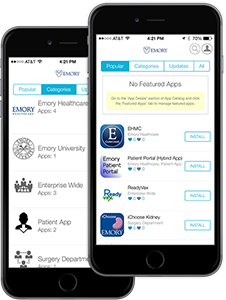 Emory has approximately 22,000 mobile devices accessing its network, yet Emory only administers fewer than 200 of these devices. This means that the environment is 99 percent "bring your own device," which required the enterprise to adopt a mobile application management solution.
Emory has approximately 22,000 mobile devices accessing its network, yet Emory only administers fewer than 200 of these devices. This means that the environment is 99 percent "bring your own device," which required the enterprise to adopt a mobile application management solution.
The internal app store offers several benefits. By using this catalog, Emory now knows what apps are in use. This allows teams to record data and perform analytics, an ability that is not available in the public marketplace. Also, the service gives Emory more access control to distribute apps to various groups, big or small.
Another bonus of the Emory Mobile App Catalog is that it does not involve controlling the user's device. Traditional mobile device management would take over a device but now users do not have to give up control of their own devices for installs. With the catalog, Emory is performing "mobile application management," which allows the removal and/or repair of problem apps without affecting the users.
Additionally, the Emory Mobile App Catalog can be used to distribute vended apps. This prevents the community from being blind-sided by vendor updates before they have been vetted by appropriate app support teams.
The Emory Mobile App Catalog can also store curated entries for apps from the public market that have been deemed useful to Emory's interests. Thus, rather than searching for an app to perform a needed task, users can choose from curated apps have already been reviewed and selected as the best for Emory's environment.
Regarding the enterprise-wide change in password policy...
"Sometimes, the reason why we’re requiring these password changes gets lost. We all need to do this to protect our information resources – our research, student information, intellectual property – and the first baseline defense around that is a strong password."
Marc Overcash
Deputy CIO LITS
